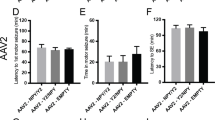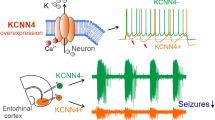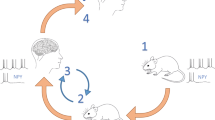Abstract
Neuropeptide Y (NPY) is an endogenous peptide with powerful anticonvulsant properties. Its overexpression in the rat hippocampus, mediated by the local application of recombinant adeno-associated viral (rAAV) vectors carrying the human NPY gene, results in significant reduction of seizures in acute and chronic seizure models. In this study, we characterized a more efficient rAAV-NPY vector to improve cell transfection in the injected area. The changes included pseudotyping with the AAV vector serotype 1 (rAAV1), and using the strong constitutive hybrid CBA promoter, which contains a cytomegalovirus enhancer and chicken β-actin promoter sequences. We compared NPY expression and the associated anticonvulsant effects of this new vector, with those mediated by the former rAAV vector with chimeric serotype 1/2 (rAAV1/2). In addition, we investigated whether rAAV serotype 1 vector-mediated chronic NPY overexpression causes behavioural deficits that may detract from the clinical utility of this therapeutic approach. We report that rAAV-NPY serotype 1 vector has significantly improved anticonvulsant activity when compared with serotype 1/2 vector, as assessed by measuring EEG seizure activity in kainic acid treated rats. rAAV1-mediated NPY overexpression in naive rats did not result in alterations of physiological functions such as learning and memory, anxiety and locomotor activity. In addition, we did not observe glia activation, or humoral immune responses against serotype 1 vector, which could inactivate gene expression. Our findings show that rAAV1-NPY vector with the CBA promoter mediates powerful anticonvulsant effects and seems to be safe in rodents, thus it may be considered a vector of choice for possible clinical applications.
This is a preview of subscription content, access via your institution
Access options
Subscribe to this journal
Receive 12 print issues and online access
$259.00 per year
only $21.58 per issue
Buy this article
- Purchase on Springer Link
- Instant access to full article PDF
Prices may be subject to local taxes which are calculated during checkout





Similar content being viewed by others
Accession codes
References
Yoon HH, Kwon HL, Mattson RH, Spencer DD, Spencer SS . Long-term seizure outcome in patients initially seizure-free after respective epilepsy surgery. Neurology 2003; 61: 445–450.
Duncan JS, Sander JW, Sisodiya SM, Walker MC . Adult epilepsy. Lancet 2006; 367: 1087–1100.
Baraban SC, Hollopeter G, Erickson JC, Schwartzkroin PA, Palmiter RD . Knock-out mice reveal a critical antiepileptic role for neuropeptide Y. J Neurosci 1997; 17: 8927–8936.
Vezzani A, Sperk G, Colmers WF, Neuropeptide Y . emerging evidence for a functional role in seizure modulation. Trends Neurosci 1999; 22: 25–30.
Vezzani A, Sperk G . Overexpression of NPY and Y2 receptors in epileptic brain tissue: an endogenous neuroprotective mechanism in temporal lobe epilepsy? Neuropeptides 2004; 38: 245–252.
Xapelli S, Agasse F, Ferreira R, Silva AP, Malva JO . Neuropeptide Y as an endogenous antiepileptic, neuroprotective and pro-neurogenic peptide. Recent Pat CNS Drug Discov 2006; 1: 315–324.
Smialowska M, Domin H, Zieba B, Kozniewska E, Michalik R, Piotrowski P et al. Neuroprotective effects of neuropeptide Y-Y2 and Y5 receptor agonists in vitro and in vivo. Neuropeptides 2009; 43: 235–249.
El Bahh B, Balosso S, Hamilton T, Herzog H, Beck-Sickinger AG, Sperk G et al. The anti-epileptic actions of neuropeptide Y in the hippocampus are mediated by Y2 and not Y5 receptors. Eur J Neurosci 2005; 22: 1417–1430.
Colmers WF, Lukowiak K, Pittman QJ . Presynaptic action of neuropeptide Y in area CA1 of the rat hippocampal slice. J Physiol 1987; 383: 285–299.
Greber S, Schwarzer C, Sperk G . Neuropeptide Y inhibits potassium-stimulated glutamate release through Y2 receptors in rat hippocampal slices in vitro. Br J Pharmacol 1994; 113: 737–740.
Nadler JV, Tu B, Timofeeva O, Jiao Y, Herzog H . Neuropeptide Y in the recurrent mossy fiber pathway. Peptides 2007; 28: 357–364.
Hokfelt T . Neuropeptides in perspective: the last ten years. Neuron 1991; 7: 867–879.
Richichi C, Lin EJ, Stefanin D, Colella D, Ravizza T, Grignaschi G et al. Anticonvulsant and antiepileptogenic effects mediated by adeno-associated virus vector neuropeptide Y expression in the rat hippocampus. J Neurosci 2004; 24: 3051–3059.
Foti S, Haberman RP, Samulski RJ, McCown TJ . Adeno-associated virus-mediated expression and constitutive secretion of NPY or NPY13–36 suppresses seizure activity in vivo. Gene Ther 2007; 14: 1534–1536.
van Vliet EA, van Schaik R, Edelbroek PM, Redeker S, Aronica E, Wadman WJ et al. Inhibition of the multidrug transporter P-glycoprotein improves seizure control in phenytoin-treated chronic epileptic rats. Epilepsia 2006; 47: 672–680.
Noe F, Pool AH, Nissinen J, Gobbi M, Bland R, Rizzi M et al. Neuropeptide Y gene therapy decreases chronic spontaneous seizures in a rat model of temporal lobe epilepsy. Brain 2008; 131: 1506–1515.
Sorensen AT, Kanter-Schlifke I, Carli M, Balducci C, Noe F, During MJ et al. NPY gene transfer in the hippocampus attenuates synaptic plasticity and learning. Hippocampus 2008; 18: 564–574.
Wettstein JG, Earley B, Junien JL . Central nervous system pharmacology of neuropeptide Y. Pharmacol Ther 1995; 65: 397–414.
Karl T, Burne TH, Herzog H . Effect of Y1 receptor deficiency on motor activity, exploration, and anxiety. Behav Brain Res 2006; 167: 87–93.
Redrobe JP, Dumont Y, St-Pierre JA, Quirion R . Multiple receptors for neuropeptide Y in the hippocampus: putative roles in seizures and cognition. Brain Res 1999; 848: 153–166.
Redrobe JP, Dumont Y, Quirion R . Neuropeptide Y (NPY) and depression: from animal studies to the human condition. Life Sci 2002; 71: 2921–2937.
Thorsell A, Heilig M . Diverse functions of neuropeptide Y revealed using genetically modified animals. Neuropeptides 2002; 36: 182–193.
Tschenett A, Singewald N, Carli M, Balducci C, Salchner P, Vezzani A et al. Reduced anxiety and improved stress coping ability in mice lacking NPY-Y2 receptors. Eur J Neurosci 2003; 18: 143–148.
Harding TC, Dickinson PJ, Roberts BN, Yendluri S, Gonzalez-Edick M, Lecouteur RA et al. Enhanced gene transfer efficiency in the murine striatum and an orthotopic glioblastoma tumor model, using AAV-7- and AAV-8-pseudotyped vectors. Hum Gene Ther 2006; 17: 807–820.
Burger C, Gorbatyuk OS, Velardo MJ, Peden CS, Williams P, Zolotukhin S et al. Recombinant AAV viral vectors pseudotyped with viral capsids from serotypes 1, 2, and 5 display differential efficiency and cell tropism after delivery to different regions of the central nervous system. Mol Ther 2004; 10: 302–317.
Taymans JM, Vandenberghe LH, Haute CV, Thiry I, Deroose CM, Mortelmans L et al. Comparative analysis of adeno-associated viral vector serotypes 1, 2, 5, 7, and 8 in mouse brain. Hum Gene Ther 2007; 18: 195–206.
Kaplitt MG, Feigin A, Tang C, Fitzsimons HL, Mattis P, Lawlor PA et al. Safety and tolerability of gene therapy with an adeno-associated virus (AAV) borne GAD gene for Parkinson's disease: an open label, phase I trial. Lancet 2007; 369: 2097–2105.
Fitzsimons HL, Bland RJ, During MJ . Promoters and regulatory elements that improve adeno-associated virus transgene expression in the brain. Methods 2002; 28: 227–236.
Klein RL, Hamby ME, Gong Y, Hirko AC, Wang S, Hughes JA et al. Dose and promoter effects of adeno-associated viral vector for green fluorescent protein expression in the rat brain. Exp Neurol 2002; 176: 66–74.
Wang C, Wang CM, Clark KR, Sferra TJ . Recombinant AAV serotype 1 transduction efficiency and tropism in the murine brain. Gene Ther 2003; 10: 1528–1534.
Hadaczek P, Forsayeth J, Mirek H, Munson K, Bringas J, Pivirotto P et al. Transduction of nonhuman primate brain with adeno-associated virus serotype 1: vector trafficking and immune response. Hum Gene Ther 2009; 20: 225–237.
Peden CS, Burger C, Muzyczka N, Mandel RJ . Circulating anti-wild-type adeno-associated virus type 2 (AAV2) antibodies inhibit recombinant AAV2 (rAAV2)-mediated, but not rAAV5-mediated, gene transfer in the brain. J Virol 2004; 78: 6344–6359.
Sanftner LM, Suzuki BM, Doroudchi MM, Feng L, McClelland A, Forsayeth JR et al. Striatal delivery of rAAV-hAADC to rats with preexisting immunity to AAV. Mol Ther 2004; 9: 403–409.
Lowenstein PR, Mandel RJ, Xiong WD, Kroeger K, Castro MG . Immune responses to adenovirus and adeno-associated vectors used for gene therapy of brain diseases: the role of immunological synapses in understanding the cell biology of neuroimmune interactions. Curr Gene Ther 2007; 7: 347–360.
Erles K, Sebokova P, Schlehofer JR . Update on the prevalence of serum antibodies (IgG and IgM) to adeno-associated virus (AAV). J Med Virol 1999; 59: 406–411.
Mueller C, Flotte TR . Clinical gene therapy using recombinant adeno-associated virus vectors. Gene Ther 2008; 15: 858–863.
Zhou Z, Zhu G, Hariri AR, Enoch MA, Scott D, Sinha R et al. Genetic variation in human NPY expression affects stress response and emotion. Nature 2008; 452: 997–1001.
Thorsell A, Michalkiewicz M, Dumont Y, Quirion R, Caberlotto L, Rimondini R et al. Behavioral insensitivity to restraint stress, absent fear suppression of behavior and impaired spatial learning in transgenic rats with hippocampal neuropeptide Y overexpression. Proc Natl Acad Sci USA 2000; 97: 12852–12857.
Flood JF, Baker ML, Hernandez EN, Morley JE . Modulation of memory processing by neuropeptide Y varies with brain injection site. Brain Res 1989; 503: 73–82.
Sorensen AT, Nikitidou L, Ledri M, Lin EJ, During MJ, Kanter-Schlifke I et al. Hippocampal NPY gene transfer attenuates seizures without affecting epilepsy-induced impairment of LTP. Exp Neurol 2009; 215: 328–333.
During MJ, Young D, Baer K, Lawlor P, Klugmann M . Development and optimization of adeno-associated virus vector transfer into the central nervous system. Methods Mol Med 2003; 76: 221–236.
Lin EJ, Richichi C, Young D, Baer K, Vezzani A, During MJ . Recombinant AAV-mediated expression of galanin in rat hippocampus suppresses seizure development. Eur J Neurosci 2003; 18: 2087–2092.
Ravizza T, Gagliardi B, Noe F, Boer K, Aronica E, Vezzani A . Innate and adaptive immunity during epileptogenesis and spontaneous seizures: evidence from experimental models and human temporal lobe epilepsy. Neurobiol Dis 2008; 29: 142–160.
Furtinger S, Pirker S, Czech T, Baumgartner C, Ransmayr G, Sperk G . Plasticity of Y1 and Y2 receptors and neuropeptide Y fibers in patients with temporal lobe epilepsy. J Neurosci 2001; 21: 5804–5812.
Carli M, Tatarczynska E, Cervo L, Samanin R . Stimulation of hippocampal 5-HT1A receptors causes amnesia and anxiolytic-like but not antidepressant-like effects in the rat. Eur J Pharmacol 1993; 234: 215–221.
Carli M, Luschi R, Garofalo P, Samanin R . 8-OH-DPAT impairs spatial but not visual learning in a water maze by stimulating 5-HT1A receptors in the hippocampus. Behav Brain Res 1995; 67: 67–74.
Crawley JN . Neuropharmacologic specificity of a simple animal model for the behavioral actions of benzodiazepines. Pharmacol Biochem Behav 1981; 15: 695–699.
Carli M, Samanin R . Potential anxiolytic properties of 8-hydroxy-2-(di-n-propylamino)tetralin, a selective serotonin 1A receptor agonist. Psychopharmacology (Berl) 1988; 94: 84–91.
Acknowledgements
We gratefully acknowledge the skilful technical assistance of Ms Anna Wieselthaler and Dr Chuansong Wang. This study was supported by EPICURE (LSH-CT-2006-037315) and Fondazione Monzino to AV.
Author information
Authors and Affiliations
Corresponding author
Ethics declarations
Competing interests
The authors declare no conflict of interest.
Additional information
Disclosure
MJD is a founder and consultant of Neurologix, Inc., a Delaware-based company that has an interest in the commercialization of recombinant AAV vectors for the treatment of neurological disorders. R Bland and H Fitzsimons are employees of this company.
Rights and permissions
About this article
Cite this article
Noe, F., Vaghi, V., Balducci, C. et al. Anticonvulsant effects and behavioural outcomes of rAAV serotype 1 vector-mediated neuropeptide Y overexpression in rat hippocampus. Gene Ther 17, 643–652 (2010). https://doi.org/10.1038/gt.2010.23
Received:
Revised:
Accepted:
Published:
Issue Date:
DOI: https://doi.org/10.1038/gt.2010.23
Keywords
This article is cited by
-
Combinatorial gene therapy for epilepsy: Gene sequence positioning and AAV serotype influence expression and inhibitory effect on seizures
Gene Therapy (2023)
-
Limbic but not non-limbic kindling impairs conditioned fear and promotes plasticity of NPY and its Y2 receptor
Brain Structure and Function (2015)
-
Molecular imaging reveals epileptogenic Ca2+-channel promoter activation in hippocampi of living mice
Brain Structure and Function (2015)
-
Gene-directed enzyme prodrug therapy for localized chemotherapeutics in allograft and xenograft tumor models
Cancer Gene Therapy (2014)
-
Neuropeptides as Targets for the Development of Anticonvulsant Drugs
Molecular Neurobiology (2014)



